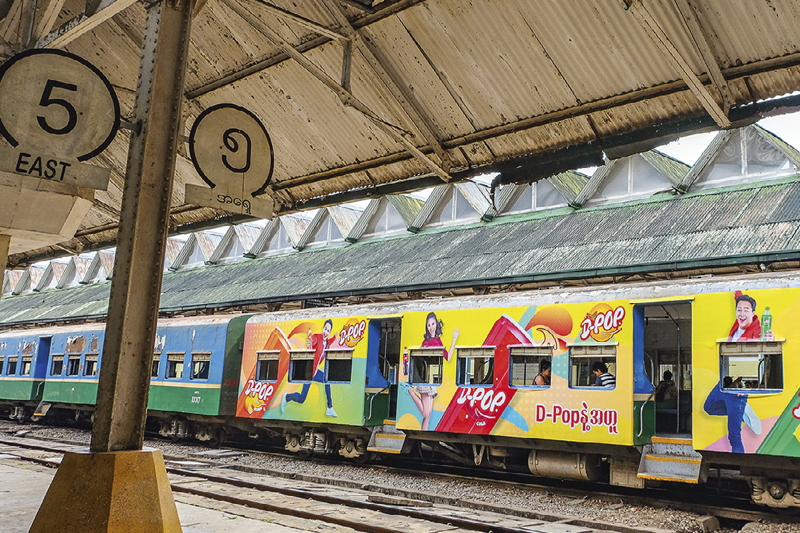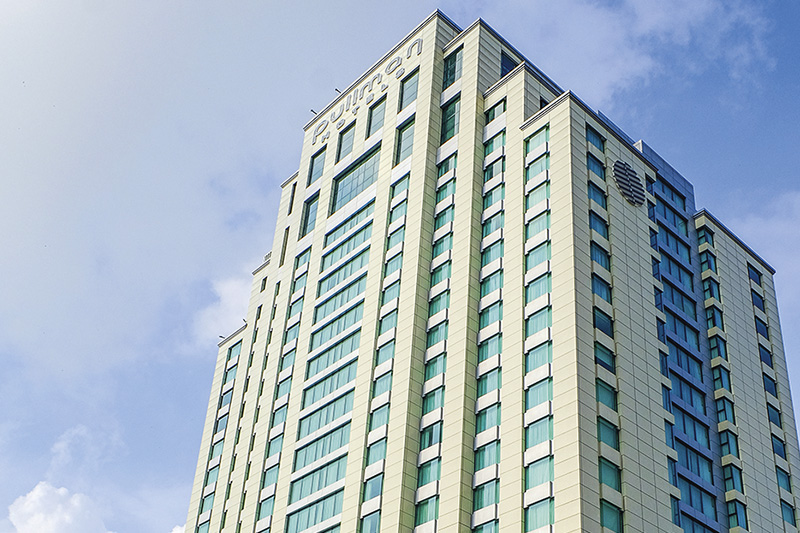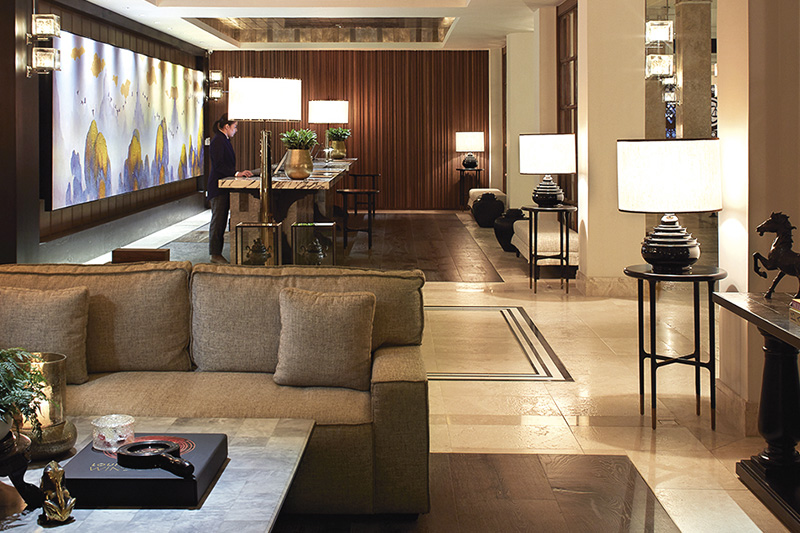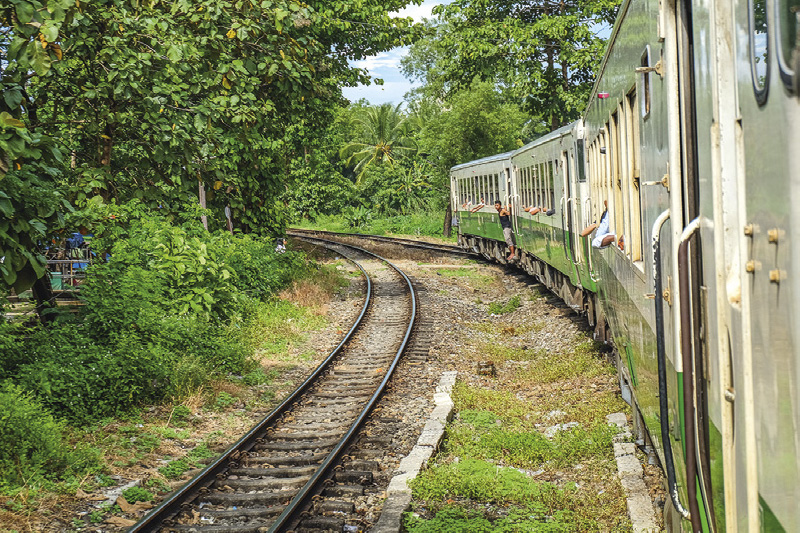
Life in the Slow Lane
The ideal way to get a taste of real daily life in Myanmar is by riding the Yangon Circle Line train.
Words & Photos: Ron Emmons
Most of us lead hectic lives, but then we also need time out to “stop and smell the roses”. On a recent trip to Myanmar, I decided to do just that and hopped on the Yangon Circle Line to do some people-watching – all for just 200 kyat (about 15 US cents).
The 46-kilometre route, which runs in a north to south loop, passes through 39 stations and takes about three hours to complete. However, I’ve heard that the line is being upgraded and that at present it is not possible to go right round the Circle Line. My quest to learn more about this upgrade took me to an office – straight out of Dickensiam times – on the top floor of the Yangon Central Railway Station, where scribes were hidden behind mounds of yellowing paperwork, with not a computer in sight. Ceiling fans were motionless and birds flitted in and out of the open windows.
Kyaw Moe Lwin, the assistant manager for Myanmar Railways, said the upgrade is being done in two phases. The first, financed by the government, entails civil work like new platforms, footbridges, drainage and level crossings, which should be completed by mid-2020. The second phase, involving newer trains and automated signaling, is being financed by Japan and should be completed by around 2022.
Once that is done, more trains will run daily, and journeys will become significantly shorter – cutting an hour off running the entire loop. He added that the station itself, which dates back to the ‘50s and is one of Yangon’s most iconic buildings, is also slated for major redevelopment.
The following day, I join tour guide Myat from Yangon Urban Adventures, US traveller Elana and Katsu from Japan to experience the ride. We board the train after 9am, so it isn’t too crowded, and our life in the slow lane begins. After a juddering clunk, the train chugs sedately out of the city, stopping every few minutes to let passengers on and off.
The carriages don’t appear to have changed much sine the line began operating in 1954, apart from wooden benches being swapped for ones made of fiberglass and the addition of some recycled coaches from Japan that boast cushioned seats.
The lack of air-conditioning, functioning toilets and doors is probably why the ride is so cheap. It also explains why most of the passengers are from the lower-income bracket, with the occasional curious foreigner like me. Presumably office workers prefer to travel on the newer, air-conditioned buses, despite Yangon’s notorious rush-hour traffic jams.
Gradually the high-rise blocks of glass and concrete in the city centre give way to single-storey, wooden houses in the suburbs, with the train rumbling past tea houses, noodle shops, temple decoration workshops and vegetable gardens. Farmers can be seen standing knee deep in lush fields and the rural traffic stops at manually operated level crossings or for red flags waved by railway staff.
Our attention isn’t always fixed on what’s happening beyond the window, as the constantly changing cast of characters on board is just as entertaining. Many of the passengers sit cross-legged on the benches or stretch out to sleep, lulled by the rhythmic clicket-clack of the wheels. Others chat or nibble on snacks, while mothers feed their babies and teenagers thumb the screens of their mobile phones.
I quickly realise that people in Myanmar love their snacks: vendors who wander through the carriages are doing a roaring trade in everything from boiled eggs, iced lollies, slices of watermelon and avocados to cakes and little betel-leaf wraps to chew on. There is even someone offering to tell people’s fortunes for 500 kyat (33 US cents).
Rules say peddlers are not allowed to sell their wares on the train, yet they are generally tolerated. Each seller uses a distinctive call to advertise their wares, and the betel vendors appear to be particularly popular.
After about an hour and a half, the train grinds to a halt where the northern stretch of the line is being upgraded. All along the track, we can see workers digging trenches for new drainage systems, laying bricks for platforms and shoveling stones to lay new sleepers and tracks. There is not a single machine to help them, which explains why the upgrade is taking so long.
We hop off the train and stroll through the trackside Danyingon Market, an enormous covered space selling fruit, vegetables and flowers. Shining piles of beautifully arranged watermelons, buckets brimming with bamboo shoots, and huge sacks of chillies, not to mention the smiling faces of vendors, certainly make for some great photographs.
However, we have to leave quickly to hail a taxi to Pa Ywet Seik Kone station on the east of the circle to catch a train back.
Despite being nowhere near downtown Yangon, we find ourselves caught in a traffic jam and miss the train at this station, but thanks to its leisurely pace, we manage to catch up with it at the next.
Once on board, we slip back into the slow life, with a new set of passengers and vendors to watch. This time, the entertainment is provided by a couple of energetic youngsters trying out their kung-fu moves on each other before their mums call a halt to the action for fear they might fall out of a window.
Finally, the circle is complete and we disembark into a crowd on the platform – some of the approximately 100,000 locals who take the Circle Line each day.
We wrap things up with a tasty lunch at a nearby café called Mya Sabei, where Katsu, Elana and I agree that our encounters on the train made the trip worthwhile. Though it’s quite possible to ride the train without a guide, we feel Myat’s informative commentary brought the scenery to life. And while it is not yet possible to complete the loop in a single journey, even riding some of the circuit is an eye-opening window on the Myanmar way of life.
Before leaving the city, I visit the Yangon Heritage Trust and speak to programs manager Ruper Mann about the role this circular railway will play in the future of Yangon, which the Trust hopes will become one of Asia’s most liveable cities.
“The upgrade is a welcome development, as it will help ease the city’s traffic problems. If possible, we want to avoid an elevated railway, as it will obscure the view of some of Yangon’s finest buildings. As for the vendors, we hope the authorities will find a middle ground, because these people are an essential part of the traditional economy,” he says.
As is evident in Yangon’s city centre, Myanmar is slowly emerging from a time warp and the upgrading of the Circle Line is part of its transformation. However, for people keen to learn about true Myanmar culture, the answer is simple: ride the Circle Lien now, before the upgrade is complete.
Where to Stay

Chatrium Hotel Royal Lake Yangon
Nestled along the bank of the enchanting Kandawgyi Lake, Chatrium Hotel Royal Lake Yangon is an urban sanctuary with stunning views of the Shwedagon Pagoda.

Pullman Centrepoint
With an ideal downtown location, attentive service, restaurants, pool and spa, this new hotel offers the perfect base from which to explore the city. pullmancentrepoint.com

Rose Garden Hotel
If you love authentic Myanmar traditions, check out Rose Garden Hotel in Yangon, where the golden Shwedagon Pagoda is within walking distance. theroseyangon.com

Rosewood Yangon
Housed in a stunning 1927 heritage building, Rosewood Yangon is situated in the heart of business district, while the city’s landmarks are just a few minutes drive away. It’s the perfect base for both leisure and business travellers. rosewoodhotels.com/en/yangon

อยากหนีความวุ่นวายมาใช้ชีวิตแบบไม่รีบร้อน จะมีการเดินทางไหนที่ดีไปกว่ารถไฟสาย Yangon Circle Line ด้วยค่าเดินทางเพียง 4 บาทเท่านั้น ก็จะได้เดินทางวนรอบเมืองย่างกุ้งผ่าน 39 สถานีในเวลา 3 ชั่วโมง รวมระยะทาง 46 กิโลเมตร
ด้วยความอยากรู้ข้อมูลเกี่ยวกับการขยายพื้นที่บริการของรถไฟสายนี้ เราจึงเดินทางไปยังสถานีรถไฟกลางย่างกุ้ง บนโต๊ะมีแต่เอกสารกองพะเนิน ไม่มีคอมพิวเตอร์ ไม่มีพัดลมเพดาน มีเพียงนกบินเข้าออกทางหน้าต่างเป็นครั้งคราว
ชอว์ โม ลวิน ผู้ช่วยผู้จัดการกล่าวว่า โครงการพัฒนาเฟสแรกที่จะสร้างเสร็จกลางปีหน้าได้รับเงินสนับสนุนจากรัฐบาลเมียนมา ส่วนเฟสที่สองได้รับการสนับสนุนงบประมาณจากประเทศญี่ปุ่น โครงการทั้งหมดที่จะเสร็จสมบูรณ์ในปี 2565 ทำให้มีเที่ยวรถไฟบริการทุกวัน ซึ่งแต่ละรอบใช้เวลาน้อยลงกว่า 1 ชั่วโมง
แล้วก็ถึงเวลาที่เราได้นั่งรถไฟสายนี้ช่วง 9 โมงเช้าคนไม่แน่นมากนัก วิถีสโลว์ไลฟ์ของเราได้เริ่มต้นขึ้น ระหว่างนั้น รถไฟก็หยุดรับส่งผู้โดยสารตามสถานีทุกๆ 2-3 นาที
สภาพโบกี้รถไฟไม่แตกต่างจากครั้งเริ่มเปิดดำเนินงานในปี 2497 เว้นแต่ที่นั่งไม้ถูกแทนที่ด้วยไฟเบอร์กลาส บางตู้ดีหน่อยมีเบาะบนที่นั่งเพราะเป็นตู้รถไฟมือสองจากญี่ปุ่น ส่วนเหตุผลที่ค่าโดยสารราคาถูกมากเห็นจะเป็นเพราะไม่มีเครื่องปรับอากาศและห้องน้ำ ทำให้คนทั่วไปเลือกที่จะนั่งรถบัสปรับอากาศแม้จะต้องทนกับรถติดแบบมหากาพย์ในย่างกุ้ง
ไม่นานนัก ทัศนียภาพของตึกสูงก็เปลี่ยนเป็นบ้านไม้ชั้นเดียว โรงน้ำชา ร้านก๋วยเตี๋ยว รวมถึงภาพเกษตรกรกำลังดำนาอย่างขะมักเขม้น
แต่ไม่ได้มีเพียงวิวนอกหน้าต่างเท่านั้นที่น่าสนใจบนรถไฟ ผู้คนนั่งไข่วห้าง บ้างก็เหยียดตัวนอน บ้างก็คุยกันอย่างออกรสพร้อมกับเคี้ยวขนมหนุบหนับ คุณแม่กำลังป้อนข้าวลูกและกลุ่มวัยรุ่นสไลด์หน้าจอโทรศัพท์อย่างเพลิดเพลิน
แม่ค้าหาบของเดินขายตามตู้รถไฟ มีของกินตั้งแต่ไข่ต้ม หวานเย็น แตงโมและอะโวคาโด ไปจนถึงขนมเค้กและเมี่ยงคำไว้ขบเคี้ยวเล่น ถ้าสนใจอยากดูดวง หมอดูก็หาไม่ได้ยากบนรถไฟขบวนนี้
เวลาผ่านไปชั่วโมงครึ่ง รถไฟหยุดบริเวณที่มีการก่อสร้างส่วนต่อขยาย คนงานกำลังก่ออิฐ วางหมอนรองรางรถไฟโดยไม่มีเครื่องจักรทุ่นแรง ทำให้การก่อสร้างดำเนินไปอย่างล่าช้า
เราลงจากรถไฟแล้วเดินต่อไปที่ตลาด Danyingon ที่มีผักและดอกไม้ขาย ท่ามกลางรอยยิ้มของพ่อค้าแม่ค้า เราต้องรีบนั่งแท็กซี่ไปยังสถานี Pa Ywet Seik Kone เพื่อนั่งรถไฟกลับ แม้จะไม่ได้อยู่ในตัวเมือง แต่พิษรถติดก็ยังตามเราไม่ไกลถึงที่นี่ ทำให้เราตกรถไฟจนต้องรอเที่ยวถัดไป
ในที่สุดเราก็กลับมายังสถานีปลายทาง จบทริปที่คาเฟ่ Mya Sabei เพื่อทานอาหารกลางวัน นึกถึงภาพวิถีชีวิตชาวเมียนมาที่เราได้เห็นผ่านหน้าต่างรถไฟ ทำให้การเดินทางครั้งนี้คุ้มค่าทีเดียว
ก่อนเดินทางออกจากย่างกุ้ง เราได้มีโอกาสพูดคุยกับผู้จัดการโครงการพัฒนารถไฟและได้ทราบว่าแผนการปรับปรุงระบบรถไฟนี้จะช่วยแก้ปัญหาการจราจรในย่างกุ้ง โดยโครงการจะหลีกเลี่ยงการสร้างรางลอยฟ้าเพื่อไม่ให้บดบังทัศนียภาพของเมือง และจะหาแนวทางการจัดระเบียบพ่อค้าแม่ค้าหาบเร่บนรถไฟเพื่อรักษาวิถีชีวิตดั้งเดิมของชาวบ้านไว้
เห็นได้ชัดว่าศูนย์กลางย่างกุ้งกำลังพัฒนาอย่างก้าวกระโดด หากคุณต้องการเรียนรู้วัฒนธรรมดั้งเดิมของชาวเมียนมา ลองมานั่งรถไฟสาย Circle Line เสียตั้งแต่ตอนนี้ ก่อนจะไม่ได้เห็นหากโครงการพัฒนาเสร็จสมบูรณ์
พักที่ไหนดี
Chatrium Hotel Royal Lake Yangon
ตั้งอยู่ริม Kandawgyi เลค โรงแรม Chatrium Hotel Royal Lake Yangon เป็นที่พักสุดหรู แถมด้วยวิวเจดีย์ชเวดากองที่เป็นแลนด์มาร์กของเมืองย่างกุ้ง Chatrium.com/Chatrium/royallakeyangon
Pullman Centrepoint
เพิ่งเปิดให้บริการเมื่อไม่นานมานี้ โรงแรม Pullman ตั้งอยู่ใจกลางเมือง เดินทางไปยังที่ต่างๆ ได้สะดวก มีร้านอาหาร สระว่ายน้ำ และสปา พร้อมการบริการชั้นเยี่ยม pullmancentrepoint.com
Rose Garden Hotel
ถ้าคุณชื่นชอบความเป็นเมียนมาที่ผสมผสานเข้ากับความทันสมัยที่ลงตัว โรงแรม Rose Garden เป็หนึ่งในทางเลือกอันดับต้นๆ เดินเพียงไม่กี่นาทีคุณก็สามารถชมเจดีย์ชเวดากองได้ง่ายๆ therosegarden.com
Rosewood Yangon
ตั้งอยู่ใจกลางย่านธุรกิจของย่างกุ้งบนอาคารเก่าแก่สวยงามที่สร้างขึ้นในปี พ.ศ. 2470 Rosewood Yangon เหมาะสำหรับทั้งนักเดินทางและนักธุรกิจ
Rosewoodhotels.com/en/yangon
การเดินทาง
จองทัวร์รถไฟสาย Circle Line กับ Yangon Urban Adventures
